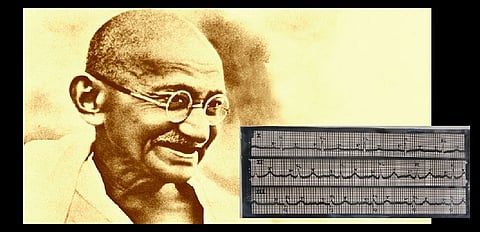

[dropcap]T[/dropcap]he National Gandhi Museum, a storehouse of original belongings of Mahatma Gandhi near Rajghat in Delhi, is all set to welcome visitors after getting a face-lift on Gandhi's birth anniversary, October 2. The latest addition to its audio-visual section is the facility for visitors to listen to his heartbeat.
"We have got the heart-beat of Mahatma Gandhi recreated on the digital medium from one of his old ECG (Electrocardiography) reports — which was done in 1934, when he was not keeping well. The ECG, according to cardiologists, has been found to be normal. The idea is to connect the people to Gandhi not just intellectually but also emotionally," said the director of the museum, A Annamalai, adding that the museum also has several other health reports of Gandhi in its rich collection.
Gandhi — who took on the might of the British Empire armed only with a message of truth and non-violence — suffered from high blood pressure. When he observed fast during the Indian independence movement, his blood pressure was monitored regularly by doctors. On March 5, 1939, his blood pressure was 180/110 whereas on March 7, 1939 it was 178/112. "After analysing these reports at the museum, doctors say that most of the times, Gandhi's blood pressure would remain high whereas his blood sugar level would remain abysmally low hovering between 80 to 40," he said, adding that it was in February 1936 when his blood sugar level was recorded at 40.
"Besides blood pressure and sugar, doctors would regularly monitor his heartbeat as well — which would invariably remain normal," he said, adding that the medical reports of Gandhi at the museum had value no less than a national heritage.
Dr Jeevram Mehta and Dr BC Roy were the prominent doctors who attended on Gandhi. "All India Institutes of Medical Sciences and Indian Council of Medical Research are soon going to publish some interesting facts about his health in the upcoming issues of medical journals," said Annamalai.
During his youth, Gandhi had to give up on his dream of becoming a doctor as his conservative father and elder brother were opposed to dissection of human cadavers. Curiously, Annamalai disclosed, Gandhi did not lose interest in the subject and during his stay in South Africa he got training in basic nursing.
Gandhi remained health-conscious and had a considerable interest in knowing about cures of several ailments. "At the time of his third son's birth, he gave a helping hand to the doctor during the delivery. Similarly, when his fourth child Devdas was born, it is said that doctor or the mid wife could not reach in time and Gandhi himself had to see through the delivery of the baby," he added. Gandhi also volunteered with the Indian Ambulance Corps in South Africa in the Anglo-Boer war.
In fact, he worked as compounder at the Saint Aidan's Mission Hospital run by Dr Lancelot Parker Booth in South Africa. Gandhi has described Dr Booth as "a kind-hearted man who treated his patients for free" and would devote two hours for the hospital every morning.
Gandhi was very conscious about his dietary habits, particularly his periodic fasting and regular walks. "At times he would walk for over 16 miles for a day," he said, adding, "Similarly, on Mondays, when he would usually remain silent, he used to write over 90 letters a day."
Several documents at the museum provide interesting insights into Gandhi's health and medical history. During high blood pressure, for example, he would apply clay to his forehead. Over the years, he lost interest in allopathic medicines and got more inclined towards herbal and natural cures besides fasting and dietary experiments.
Though he had vowed not to take milk, but to recover from a serious ailment, he added goat milk to his daily diet on the insistence of his wife. A staunch vegetarian, Gandhi — who had a minimalist approach to diet intake — would prefer to have milk, curd, garlic, honey, boiled egg, soyabean, green vegetables, oranges, neem leaves, apple, sugarcane juice. He would also take honey with lukewarm water at 4 am in the morning.